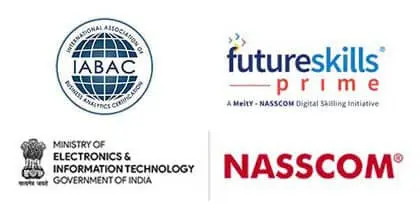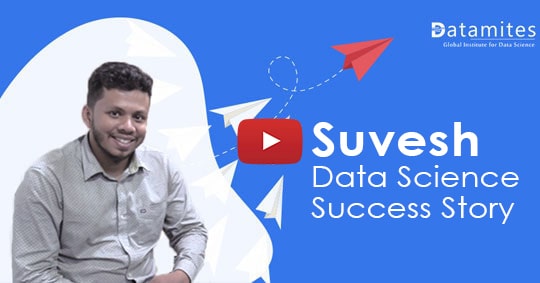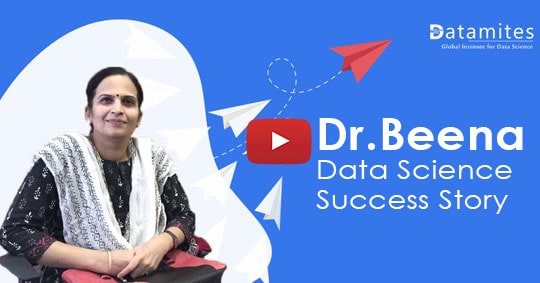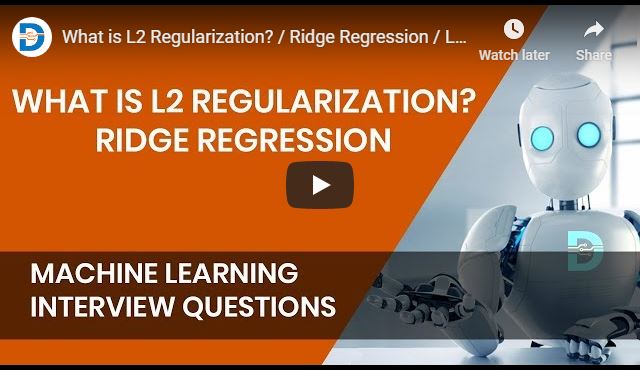Instructor Led Live Online
Self Learning + Live Mentoring
Customize Your Training
The entire training includes real-world projects and highly valuable case studies.
IABAC® certification provides global recognition of the relevant skills, thereby opening opportunities across the world.
MODULE 1: DATA SCIENCE ESSENTIALS
• Introduction to Data Science
• Evolution of Data Science
• Big Data Vs Data Science
• Data Science Terminologies
• Data Science vs AI/Machine Learning
• Data Science vs Analytics
MODULE 2: DATA SCIENCE DEMO
• Business Requirement: Use Case
• Data Preparation
• Machine learning Model building
• Prediction with ML model
• Delivering Business Value.
MODULE 3: ANALYTICS CLASSIFICATION
• Types of Analytics
• Descriptive Analytics
• Diagnostic Analytics
• Predictive Analytics
• Prescriptive Analytics
• EDA and insight gathering demo in Tableau
MODULE 4: DATA SCIENCE AND RELATED FIELDS
• Introduction to AI
• Introduction to Computer Vision
• Introduction to Natural Language Processing
• Introduction to Reinforcement Learning
• Introduction to GAN
• Introduction to Generative Passive Models
MODULE 5: DATA SCIENCE ROLES & WORKFLOW
• Data Science Project workflow
• Roles: Data Engineer, Data Scientist, ML Engineer and MLOps Engineer
• Data Science Project stages.
MODULE 6: MACHINE LEARNING INTRODUCTION
• What Is ML? ML Vs AI
• ML Workflow, Popular ML Algorithms
• Clustering, Classification And Regression
• Supervised Vs Unsupervised
MODULE 7: DATA SCIENCE INDUSTRY APPLICATIONS
• Data Science in Finance and Banking
• Data Science in Retail
• Data Science in Health Care
• Data Science in Logistics and Supply Chain
• Data Science in Technology Industry
• Data Science in Manufacturing
• Data Science in Agriculture
MODULE 1: PYTHON BASICS
• Introduction of python
• Installation of Python and IDE
• Python Variables
• Python basic data types
• Number & Booleans, strings
• Arithmetic Operators
• Comparison Operators
• Assignment Operators
MODULE 2: PYTHON CONTROL STATEMENTS
• IF Conditional statement
• IF-ELSE
• NESTED IF
• Python Loops basics
• WHILE Statement
• FOR statements
• BREAK and CONTINUE statements
MODULE 3: PYTHON DATA STRUCTURES
• Basic data structure in python
• Basics of List
• List: Object, methods
• Tuple: Object, methods
• Sets: Object, methods
• Dictionary: Object, methods
MODULE 4: PYTHON FUNCTIONS
• Functions basics
• Function Parameter passing
• Lambda functions
• Map, reduce, filter functions
MODULE 1: OVERVIEW OF STATISTICS
• Introduction to Statistics
• Descriptive And Inferential Statistics
• Basic Terms Of Statistics
• Types Of Data
MODULE 2: HARNESSING DATA
• Random Sampling
• Sampling With Replacement And Without Replacement
• Cochran's Minimum Sample Size
• Types of Sampling
• Simple Random Sampling
• Stratified Random Sampling
• Cluster Random Sampling
• Systematic Random Sampling
• Multi stage Sampling
• Sampling Error
• Methods Of Collecting Data
MODULE 3: EXPLORATORY DATA ANALYSIS
• Exploratory Data Analysis Introduction
• Measures Of Central Tendencies: Mean,Median And Mode
• Measures Of Central Tendencies: Range, Variance And Standard Deviation
• Data Distribution Plot: Histogram
• Normal Distribution & Properties
• Z Value / Standard Value
• Empirical Rule and Outliers
• Central Limit Theorem
• Normality Testing
• Skewness & Kurtosis
• Measures Of Distance: Euclidean, Manhattan And Minkowski Distance
• Covariance & Correlation
MODULE 4: HYPOTHESIS TESTING
• Hypothesis Testing Introduction
• P- Value, Critical Region
• Types of Hypothesis Testing
• Hypothesis Testing Errors : Type I And Type II
• Two Sample Independent T-test
• Two Sample Relation T-test
• One Way Anova Test
• Application of Hypothesis testing
MODULE 1: MACHINE LEARNING INTRODUCTION
• What Is ML? ML Vs AI
• Clustering, Classification And Regression
• Supervised Vs Unsupervised
MODULE 2: PYTHON NUMPY PACKAGE
• Introduction to Numpy Package
• Array as Data Structure
• Core Numpy functions
• Matrix Operations, Broadcasting in Arrays
MODULE 3: PYTHON PANDAS PACKAGE
• Introduction to Pandas package
• Series in Pandas
• Data Frame in Pandas
• File Reading in Pandas
• Data munging with Pandas
MODULE 4: VISUALIZATION WITH PYTHON - Matplotlib
• Visualization Packages (Matplotlib)
• Components Of A Plot, Sub-Plots
• Basic Plots: Line, Bar, Pie, Scatter
MODULE 5: PYTHON VISUALIZATION PACKAGE - SEABORN
• Seaborn: Basic Plot
• Advanced Python Data Visualizations
MODULE 6: ML ALGO: LINEAR REGRESSSION
• Introduction to Linear Regression
• How it works: Regression and Best Fit Line
• Modeling and Evaluation in Python
MODULE 7: ML ALGO: LOGISTIC REGRESSION
• Introduction to Logistic Regression
• How it works: Classification & Sigmoid Curve
• Modeling and Evaluation in Python
MODULE 8: ML ALGO: K MEANS CLUSTERING
• Understanding Clustering (Unsupervised)
• K Means Algorithm
• How it works : K Means theory
• Modeling in Python
MODULE 9: ML ALGO: KNN
• Introduction to KNN
• How It Works: Nearest Neighbor Concept
• Modeling and Evaluation in Python
MODULE 1: FEATURE ENGINEERING
• Introduction to Feature Engineering
• Feature Engineering Techniques: Encoding, Scaling, Data Transformation
• Handling Missing values, handling outliers
• Creation of Pipeline
• Use case for feature engineering
MODULE 2: ML ALGO: SUPPORT VECTOR MACHINE (SVM)
• Introduction to SVM
• How It Works: SVM Concept, Kernel Trick
• Modeling and Evaluation of SVM in Python
MODULE 3: PRINCIPAL COMPONENT ANALYSIS (PCA)
• Building Blocks Of PCA
• How it works: Finding Principal Components
• Modeling PCA in Python
MODULE 4: ML ALGO: DECISION TREE
• Introduction to Decision Tree & Random Forest
• How it works
• Modeling and Evaluation in Python
MODULE 5: ENSEMBLE TECHNIQUES - BAGGING
• Introduction to Ensemble technique
• Bagging and How it works
• Modeling and Evaluation in Python
MODULE 6: ML ALGO: NAÏVE BAYES
• Introduction to Naive Bayes
• How it works: Bayes' Theorem
• Naive Bayes For Text Classification
• Modeling and Evaluation in Python
MODULE 7: GRADIENT BOOSTING, XGBOOST
• Introduction to Boosting and XGBoost
• How it works?
• Modeling and Evaluation of in Python
MODULE 1: TIME SERIES FORECASTING - ARIMA
• What is Time Series?
• Trend, Seasonality, cyclical and random
• Stationarity of Time Series
• Autoregressive Model (AR)
• Moving Average Model (MA)
• ARIMA Model
• Autocorrelation and AIC
• Time Series Analysis in Python
MODULE 2: SENTIMENT ANALYSIS
• Introduction to Sentiment Analysis
• NLTK Package
• Case study: Sentiment Analysis on Movie Reviews
MODULE 3: REGULAR EXPRESSIONS WITH PYTHON
• Regex Introduction
• Regex codes
• Text extraction with Python Regex
MODULE 4: ML MODEL DEPLOYMENT WITH FLASK
• Introduction to Flask
• URL and App routing
• Flask application – ML Model deployment
MODULE 5: ADVANCED DATA ANALYSIS WITH MS EXCEL
• MS Excel core Functions
• Advanced Functions (VLOOKUP, INDIRECT..)
• Linear Regression with EXCEL
• Data Table
• Goal Seek Analysis
• Pivot Table
• Solving Data Equation with EXCEL
MODULE 6: AWS CLOUD FOR DATA SCIENCE
• Introduction of cloud
• Difference between GCC, Azure, AWS
• AWS Service ( EC2 instance)
MODULE 7: AZURE FOR DATA SCIENCE
• Introduction to AZURE ML studio
• Data Pipeline
• ML modeling with Azure
MODULE 8: INTRODUCTION TO DEEP LEARNING
• Introduction to Artificial Neural Network, Architecture
• Artificial Neural Network in Python
• Introduction to Convolutional Neural Network, Architecture
• Convolutional Neural Network in Python
MODULE 1: DATABASE INTRODUCTION
• DATABASE Overview
• Key concepts of database management
• Relational Database Management System
• CRUD operations
MODULE 2: SQL BASICS
• Introduction to Databases
• Introduction to SQL
• SQL Commands
• MY SQL workbench installation
MODULE 3: DATA TYPES AND CONSTRAINTS
• Numeric, Character, date time data type
• Primary key, Foreign key, Not null
• Unique, Check, default, Auto increment
MODULE 4: DATABASES AND TABLES (MySQL)
• Create database
• Delete database
• Show and use databases
• Create table, Rename table
• Delete table, Delete table records
• Create new table from existing data types
• Insert into, Update records
• Alter table
MODULE 5: SQL JOINS
• Inner Join, Outer Join
• Left Join, Right Join
• Self Join, Cross join
• Windows function: Over, Partition, Rank
MODULE 6: SQL COMMANDS AND CLAUSES
• Select, Select distinct
• Aliases, Where clause
• Relational operators, Logical
• Between, Order by, In
• Like, Limit, null/not null, group by
• Having, Sub queries
MODULE 7 : DOCUMENT DB/NO-SQL DB
• Introduction of Document DB
• Document DB vs SQL DB
• Popular Document DBs
• MongoDB basics
• Data format and Key methods
MODULE 1: GIT INTRODUCTION
• Purpose of Version Control
• Popular Version control tools
• Git Distribution Version Control
• Terminologies
• Git Workflow
• Git Architecture
MODULE 2: GIT REPOSITORY and GitHub
• Git Repo Introduction
• Create New Repo with Init command
• Git Essentials: Copy & User Setup
• Mastering Git and GitHub
MODULE 3: COMMITS, PULL, FETCH AND PUSH
• Code Commits
• Pull, Fetch and Conflicts resolution
• Pushing to Remote Repo
MODULE 4: TAGGING, BRANCHING AND MERGING
• Organize code with branches
• Checkout branch
• Merge branches
• Editing Commits
• Commit command Amend flag
• Git reset and revert
MODULE 5: GIT WITH GITHUB AND BITBUCKET
• Creating GitHub Account
• Local and Remote Repo
• Collaborating with other developers
MODULE 1: BIG DATA INTRODUCTION
• Big Data Overview
• Five Vs of Big Data
• What is Big Data and Hadoop
• Introduction to Hadoop
• Components of Hadoop Ecosystem
• Big Data Analytics Introduction
MODULE 2 : HDFS AND MAP REDUCE
• HDFS – Big Data Storage
• Distributed Processing with Map Reduce
• Mapping and reducing stages concepts
• Key Terms: Output Format, Partitioners,
• Combiners, Shuffle, and Sort
MODULE 3: PYSPARK FOUNDATION
• PySpark Introduction
• Spark Configuration
• Resilient distributed datasets (RDD)
• Working with RDDs in PySpark
• Aggregating Data with Pair RDDs
MODULE 4: SPARK SQL and HADOOP HIVE
• Introducing Spark SQL
• Spark SQL vs Hadoop Hive
MODULE 1: TABLEAU FUNDAMENTALS
• Introduction to Business Intelligence & Introduction to Tableau
• Interface Tour, Data visualization: Pie chart, Column chart, Bar chart.
• Bar chart, Tree Map, Line Chart
• Area chart, Combination Charts, Map
• Dashboards creation, Quick Filters
• Create Table Calculations
• Create Calculated Fields
• Create Custom Hierarchies
MODULE 2: POWER-BI BASICS
• Power BI Introduction
• Basics Visualizations
• Dashboard Creation
• Basic Data Cleaning
• Basic DAX FUNCTION
MODULE 3 : DATA TRANSFORMATION TECHNIQUES
• Exploring Query Editor
• Data Cleansing and Manipulation:
• Creating Our Initial Project File
• Connecting to Our Data Source
• Editing Rows
• Changing Data Types
• Replacing Values
MODULE 4: CONNECTING TO VARIOUS DATA SOURCES
• Connecting to a CSV File
• Connecting to a Webpage
• Extracting Characters
• Splitting and Merging Columns
• Creating Conditional Columns
• Creating Columns from Examples
• Create Data Model
DataMites™ Certified Data scientist is designed to provide a right blend of all four facets of Data Science
This course comes as a perfect package of required Data Science skills including programming, statistics and Machine Learning. If you aspire to be a Data Science professional, this course can immensely help you to reach your goal.
Data science is the hottest field in the market as on today. Be it a small company or an MNC, they need a Data scientist to manage their large pool of data.
This course “Certified Data scientist” is not restricted to any specific domain.
DataMites™ is the global institute for Data Science accredited by International Association of Business Analytics Certifications (IABAC). DataMites provides flexible learning options from Classroom training, Live Online to high quality recorded sessions
The 6 Key reasons to choose Data Mites™
IABAC™ Accredited
Elite Faculty & Mentors
Learning Approach
10+ Industry Projects
PAT (Placement Assistance Team)
24x7 Cloud Lab for ONE year
Technical skills like data analysis, statistical knowledge, data storytelling, communication, and problem-solving would be advantageous for learning DataScience.
CDS Course is designed for data science freshers who wish to mark their grades and conquer the world of Data Science.
The Certified Data Scientist Course fee is:
The USA - 1171.73 USD
Discounted price - 790 USD
India - 88,000 INR
Discounted price - 59,878 INR
Europe - 1031.40 Euro
Discounted price - 790 Euro
At DataMites you will have CDS training for a period of 8 months.
Yes, we have a dedicated Placement Assistance Team (PAT) who will provide you with placement facilities after the completion of the course.
As per Glassdoor:
The national average Data Scientist salary in India is 10,00,000 per year.
The Highest Data Scientist Salary in India - 23,00,000 per year
The Lowest Data Scientist Salary in India - 5,00,000 per year
The national average Data Scientist salary in the United States is $1,17,212 USD per annum.
A data scientist in the UK earns an average salary of £52,052 a year.
The salary for a data scientist in Canada is CA$96,280 per annum.
A data scientist's salary in Australia is A$112,979 a year, per Indeed.com.
A data scientist in Germany earns an average salary of €55,443 a year. (Payscale)
The national average Data Scientist salary in Switzerland is CHF 1,34,880 per year.
A data scientist in UAE earns an average salary of AED 177,062 a year.
The national average Data Scientist salary in Saudi Arabia is SAR 175,058 per year. (Payscale)
A data scientist in South Africa earns an average salary of ZAR 418,288 a year. (Payscale)
Data is meaningless until its conversion into valuable information. Data Science involves mining large datasets containing structured and unstructured data and identifying hidden patterns to extract actionable insights.
Data without science is nothing
Better customer experience
Increasing job opportunities
Escalating pay for Data science professionals
You will have numerous job titles from which to choose
You will be at the centre of decision-making in the company
Anyone, whether a newcomer or a professional, willing to learn Data Science can opt for it. Engineers, Marketing Professionals, Software, and IT professionals can take up part-time or external programs in Data Science. For regular courses in Data Science, basic high school level subjects are the minimum requirement.
The Data Science Course Fee would vary according to the level of training you are looking for. However, when we discuss fee structure, irrespective of any training provider that you choose for your classroom training for Data Science, it is ranging from USD 399.70 to USD 1332.33.
Data Scientist
Machine-Learning Engineer
Machine-Learning Scientist
Application Architect
Data Architect
Data Engineer
Statistician
Data Analyst
Business Intelligence Analyst
Marketing Analyst
Having an understanding of Python, R, Excel, C++, Java and SQL is always preferred. But you can always learn from the basics and improve yourself.
Like any other field, with proper guidance Data Science can become an easy field to learn about, and one can build a career in the field. However, as it is vast, it is easy for a beginner to get lost and lose sight, making the learning experience difficult and frustrating
Some major Data Science tools include; SAS, Apache Hadoop, Tableau, BigML, BigML, Knime, RapidMiner, Excel, Apache Flink, and Power BI.
According to IDC, by 2025, global data will grow to 175 zettabytes. Data Science enables companies to efficiently understand gigantic data from multiple sources and derive valuable insights to make smarter data-driven decisions. Data Science is widely used in various industry domains, including marketing, healthcare, finance, banking, policy work, and more. That explains why Data Science is important.
Yes, companies do hire freshers for Data Scientist positions. In fact, most of the entry-level analytics jobs in India don’t need any specialization or post-graduation. The only qualification you need in these companies is an Engineering Degree and even the stream doesn’t matter. These companies only look for your Aptitude, communication skills and critical reasoning.
Datamites does provide classroom training, but only in Bangalore. We would be pleased to host one in other locations, ON-DEMAND of the applicants as according to the availability of other candidates from the exact location.
We are adamant in providing you with instructors who are certified and highly qualified with decades of experience in the industry and well versed in the subject matter.
We provide you with flexible learning options from Live Online, self-study methods to Classroom training. You can choose the one preferable to you.
Our Flexi-Pass for CDS training will allow you to attend sessions from DataMites for a period of 3 months concerning any queries or revisions you would like to clear.
We will issue you with IABAC® certification that would provide global recognition of the relevant skills.
Definitely, after the completion of your course, we will issue you with a course completion certificate.
Yes. Photo ID Proof such as a National ID card, Driving License etc are required for issuing a Participation Certificate and booking certification exam as required.
You needn’t worry about that. Just contact your trainers regarding the same and fix a class according to your schedule. In the case of online training, every session will be recorded and uploaded so that you can easily learn whatever you missed at your own pace and comfort.
Yes, you shall be provided with a free demo class so as to give a brief idea of how the training will be done and what the training will cover.
We provide flexible learning options from Live Online, self-study methods to classroom training. You can choose the one preferable to you.
DataMites provides a three-phase learning method. In Phase 1, candidates would be provided with self-study videos and books to help them gain ample information about the course.
Phase 2 is the primary stage of Intensive live online training and after the training, you will receive IABAC Certified Data Scientist Certification which is a global certification. And in the third phase, we will issue projects and placements.
Learning through a case study approach
Theory → Hands-On → Case Study → Project→ Model Deployment
Yes for sure, it’s important that you make the most out of your training sessions. You surely can ask for support sessions if you need any further clarifications.
We accept payment via;
Cash
Net Banking
Credit Card
PayPal
Visa
Master Card
American Express
Cheque
Debit Card
The DataMites Placement Assistance Team(PAT) facilitates the aspirants in taking all the necessary steps in starting their career in Data Science. Some of the services provided by PAT are: -
The DataMites Placement Assistance Team(PAT) conducts sessions on career mentoring for the aspirants with a view of helping them realize the purpose they have to serve when they step into the corporate world. The students are guided by industry experts about the various possibilities in the Data Science career, this will help the aspirants to draw a clear picture of the career options available. Also, they will be made knowledgeable about the various obstacles they are likely to face as a fresher in the field, and how they can tackle.
No, PAT does not promise a job, but it helps the aspirants to build the required potential needed in landing a career. The aspirants can capitalize on the acquired skills, in the long run, to a successful career in Data Science.













